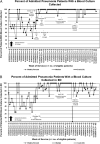Improvement methodology increases guideline recommended blood cultures in children with pneumonia
- PMID: 25780070
- PMCID: PMC9923570
- DOI: 10.1542/peds.2014-2077
Improvement methodology increases guideline recommended blood cultures in children with pneumonia
Abstract
Background and objective: A national evidence-based guideline for the management of community-acquired pneumonia (CAP) in children recommends blood cultures for patients admitted with moderate to severe illness. Our primary aim was to increase ordering of blood cultures for children hospitalized with CAP from 53% to 90% in 6 months. The secondary aim was to evaluate the effect of obtaining blood cultures on length of stay (LOS).
Methods: At a tertiary children's hospital, interventions to increase blood cultures focused on 3 key drivers and were tested separately in the emergency department and inpatient units by using multiple plan-do-study-act cycles. The impact of the interventions was tracked over time on run charts. The association of ordering blood cultures and LOS was estimated by using linear regression models.
Results: Within 6 months, the percentage of patients admitted with CAP who had blood cultures ordered increased from 53% to 100%. This change has been sustained for 12 months. Overall, 239 (79%) of the 303 included patients had a blood culture ordered; of these, 6 (2.5%) were positive. Patients who had a blood culture did not have an increased LOS compared with those without a blood culture.
Conclusions: Quality improvement methods were used to increase adherence to evidence-based national guidelines for performing blood cultures on children hospitalized with CAP; LOS did not increase. These results support obtaining blood cultures on all patients admitted with CAP without negative effects on LOS in a setting with a reliably low false-positive blood culture rate.
Keywords: blood culture; pediatric; pneumonia.
Copyright © 2015 by the American Academy of Pediatrics.
Conflict of interest statement
Figures



Comment in
-
Improvement Without Value.Pediatrics. 2015 Aug;136(2):e549. doi: 10.1542/peds.2015-1549A. Pediatrics. 2015. PMID: 26232445 No abstract available.
-
Author's Response.Pediatrics. 2015 Aug;136(2):e549-50. doi: 10.1542/peds.2015-1549B. Pediatrics. 2015. PMID: 26232446 No abstract available.
References
-
- Bradley JS , Byington CL , Shah SS , et al. Executive summary: the management of community-acquired pneumonia in infants and children older than 3 months of age: clinical practice guidelines by the Pediatric Infectious Diseases Society and the Infectious Diseases Society of America. Clin Infect Dis. 2011;53(7):617–630 - PMC - PubMed
-
- Heine D , Cochran C , Moore M , Titus MO , Andrews AL . The prevalence of bacteremia in pediatric patients with community-acquired pneumonia: guidelines to reduce the frequency of obtaining blood cultures. Hosp Pediatr. 2013;3(2):92–96 - PubMed
-
- Hickey RW , Bowman MJ , Smith GA . Utility of blood cultures in pediatric patients found to have pneumonia in the emergency department. Ann Emerg Med. 1996;27(6):721–725 - PubMed
Publication types
MeSH terms
Substances
Grants and funding
LinkOut - more resources
Full Text Sources
Miscellaneous

